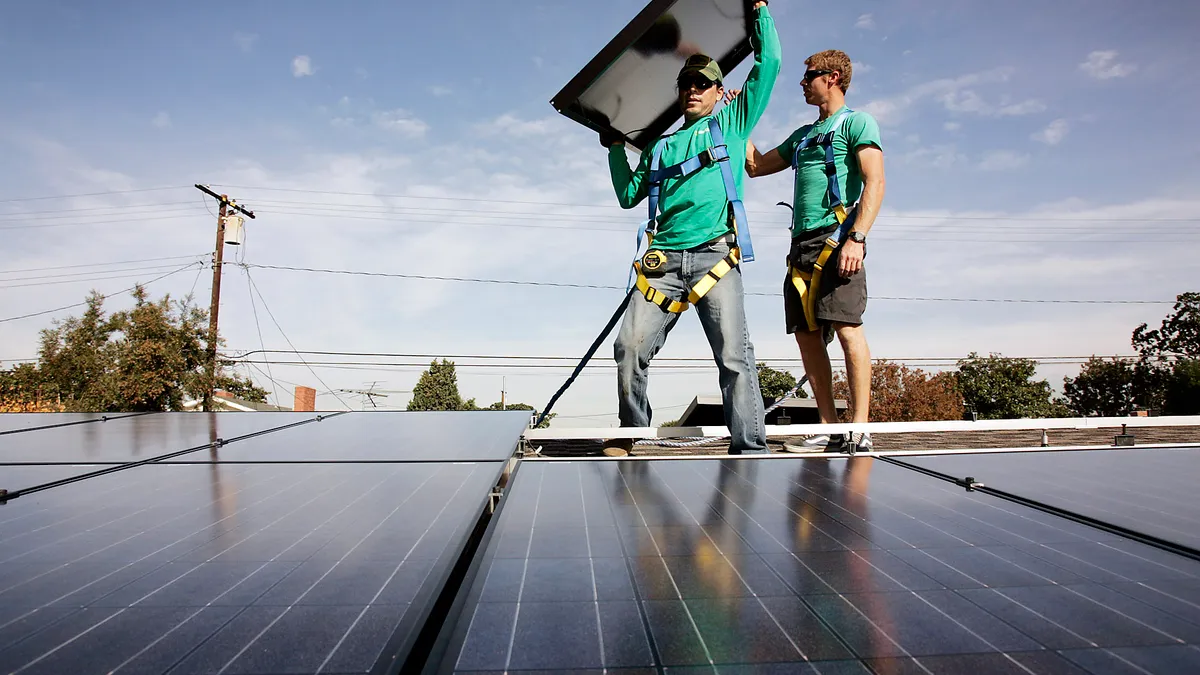Dive Brief:
- SolarCity, the leading U.S. rooftop solar installer, introduced a new set of services for utilities and grid operators Thursday, including installation, financing and consulting on utility-scale solar and energy storage, as well as new controls for demand response and aggregated distributed resources.
- The company says its new software platform can turn a utility-scale solar project with energy storage into a dispatchable resource, providing high-return capacity services and helping utilities avoid capacity charges and manage demand peaks more cost-effectively than traditional generation.
- The Connecticut Municipal Electric Energy Cooperative (CMEEC) will be the off-taker and beneficiary of SolarCity capacity services in a set of solar projects totaling 13 MW in combination with 1.5 MW (6 MWh) of storage, the company also announced Thursday. SolarCity will finance and develop the projects in partnership with Brightfields Development.
Dive Insight:
Often seen as a competitive threat to utilities, SolarCity is moving closer with this announcement to its stated goal of being a partner for utilities in deploying and operating solar and storage, both at grid scale and on the distribution system.
As power systems across the U.S. move from a centralized model to a more distributed one, aggregation and control services like the ones announced by SolarCity are expected to be crucial to enabling the transition. While utilities are becoming increasingly comfortable with managing a system with growing levels of DERs, they lack software solutions that allow them to control the resources on their distribution systems.
The new SolarCity software platform aims to change that, offering advanced controls for demand response, distributed energy resources (DERs), and aggregated grid services. Grouping DERs into a single, controllable package can offer utilities and grid operators increased flexibility through peak shaving, flexible ramping, frequency regulation and power support, the company said.
SolarCity is already testing some of those concepts in a pilot project with Southern California Edison that aims to assess the value of aggregated DERs in California electricity markets.
But the SolarCity announcement Thursday was about more than distributed energy — the company is launching services for the utility-scale market as well. Using its software platform, SolarCity says utilities can convert solar arrays equipped with storage into fully-dispatchable power plants — delivering on-demand electricity regardless of the sun's presence.
Pairing large storage facilities with renewable generation could help utilities dramatically reduce the need for fossil fuels on the grid, but the concept is still too expensive in most electricity markets to compete with natural gas generators. One exception is Hawaii, where SolarCity has partnered with the Kauai Island Utility Cooperative to deploy a fully-dispatchable 13 MW solar array paired with a 52 MWh battery.
As solar and storage prices continue to fall, these projects could become economical elsewhere, such as the Northeast. Along with its software rollout, SolarCity announced a solar-plus-storage project with Connecticut muni CMEEC that the utility will be able to control using the company's GridLogic control platform. The software will allow CMEEC to remotely and instantaneously dispatch stored solar energy to manage load spikes and optimize distribution system operations.
Recent news involving SolarCity suggests it expects high demand from utilities and end users alike for its solar-plus-storage offerings. Last week, a regulatory filing from sister company Tesla revealed that it plans to sell more battery capacity to SolarCity in 2016 than the entire U.S. behind-the-meter storage market deployed over all of last year.













